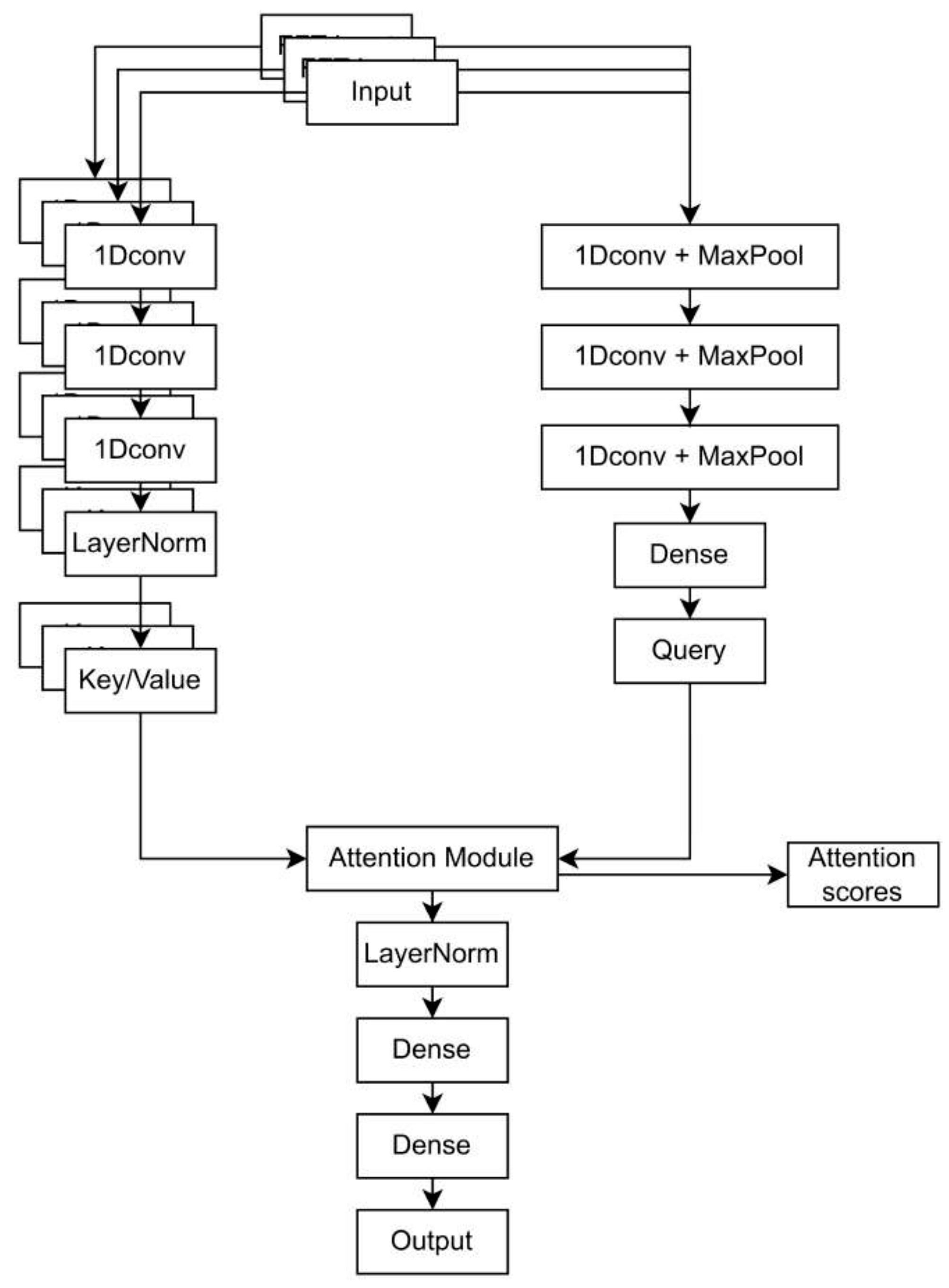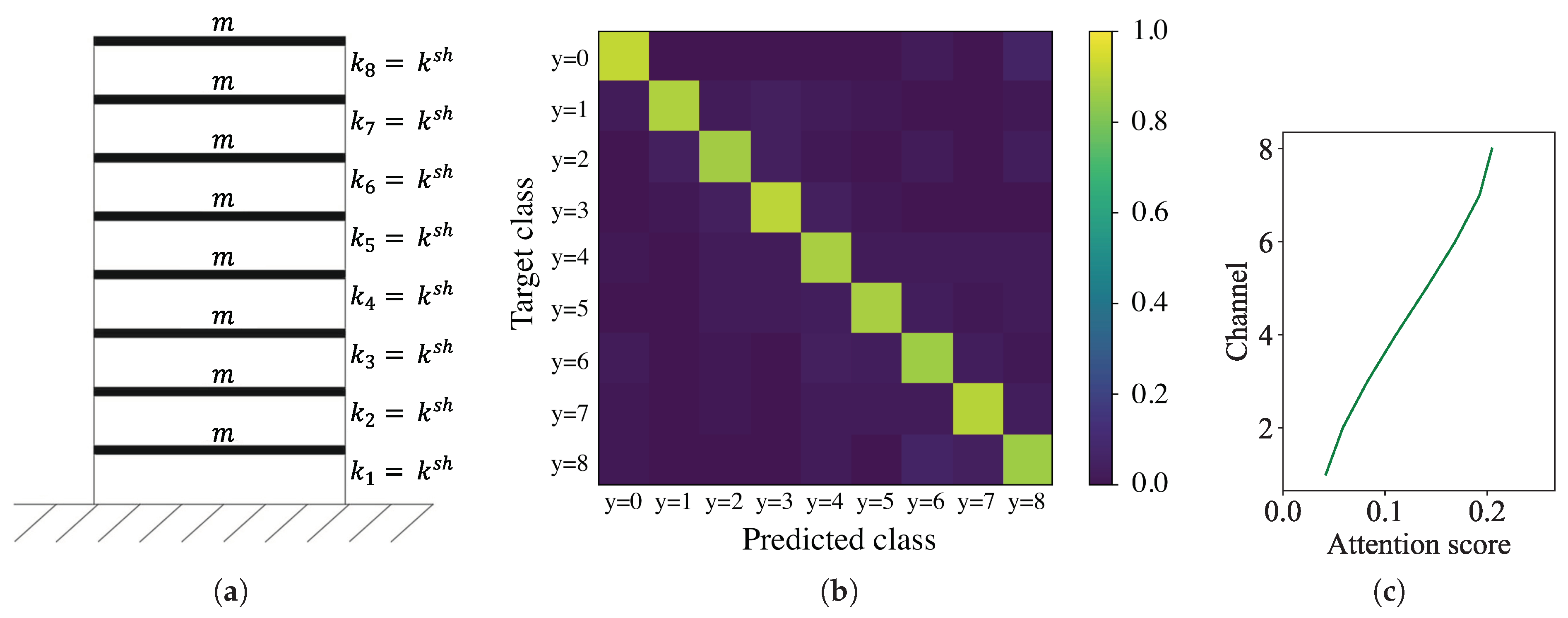Attention Mechanism-Driven Sensor Placement Strategy for Structural Health Monitoring †
Abstract
1. Introduction
2. SHM Methodology
2.1. Datasets Definition
2.2. Attention Mechanism for Data Analytics in SHM
2.3. Attention-Mechanism-Driven Sensor Placement
3. Results: Eight-Story Shear Building
4. Conclusions
Author Contributions
Funding
Institutional Review Board Statement
Informed Consent Statement
Data Availability Statement
Acknowledgments
Conflicts of Interest
References
- Torzoni, M.; Manzoni, A.; Mariani, S. Structural health monitoring of civil structures: A diagnostic framework powered by deep metric learning. Comput. Struct. 2022, 271, 106858. [Google Scholar] [CrossRef]
- Rosafalco, L.; Torzoni, M.; Manzoni, A.; Mariani, S.; Corigliano, A. Online structural health monitoring by model order reduction and deep learning algorithms. Comput. Struct. 2021, 255, 106604. [Google Scholar] [CrossRef]
- Torzoni, M.; Manzoni, A.; Mariani, S. A Deep Neural Network, Multi-fidelity Surrogate Model Approach for Bayesian Model Updating in SHM. In European Workshop on Structural Health Monitoring; Springer International Publishing: Berlin/Heidelberg, Germany, 2023; pp. 1076–1086. [Google Scholar] [CrossRef]
- Rosafalco, L.; Torzoni, M.; Manzoni, A.; Mariani, S.; Corigliano, A. A Self-adaptive Hybrid Model/data-Driven Approach to SHM Based on Model Order Reduction and Deep Learning. In Structural Health Monitoring Based on Data Science Techniques; Springer International Publishing: Berlin/Heidelberg, Germany, 2022; pp. 165–184. [Google Scholar] [CrossRef]
- García-Macías, E.; Ubertini, F. Integrated SHM Systems: Damage Detection Through Unsupervised Learning and Data Fusion. In Structural Health Monitoring Based on Data Science Techniques; Springer International Publishing: Berlin/Heidelberg, Germany, 2022; pp. 247–268. [Google Scholar] [CrossRef]
- Ostachowicz, W.; Soman, R.; Malinowski, P. Optimization of sensor placement for structural health monitoring: A review. Struct. Health Monit. 2019, 18, 963–988. [Google Scholar] [CrossRef]
- Shi, Z.Y.; Law, S.S.; Zhang, L.M. Optimum Sensor Placement for StructuralDamage Detection. J. Eng. Mech. 2000, 126, 1173–1179. [Google Scholar] [CrossRef]
- Penny, J.E.T.; Friswell, M.I.; Garvey, S.D. Automatic choice of measurement locations for dynamic testing. AIAA J. 1994, 32, 407–414. [Google Scholar] [CrossRef]
- Capellari, G.; Chatzi, E.; Mariani, S. Structural Health Monitoring Sensor Network Optimization through Bayesian Experimental Design. ASCE-ASME J. Risk Uncertain. Eng. Syst. 2018, 4, 04018016. [Google Scholar] [CrossRef]
- Capellari, G.; Chatzi, E.; Mariani, S. Cost-benefit optimization of structural health monitoring sensor networks. Sensors 2018, 18, 2174. [Google Scholar] [CrossRef] [PubMed]
- Malings, C.; Pozzi, M. Value-of-information in spatio-temporal systems: Sensor placement and scheduling. Reliab. Eng. Syst. 2018, 172, 45–57. [Google Scholar] [CrossRef]
- Kamariotis, A.; Chatzi, E.; Straub, D. Value of information from vibration-based structural health monitoring extracted via Bayesian model updating. Mech. Syst. Signal Process. 2022, 166, 108465. [Google Scholar] [CrossRef]
- Bahdanau, D.; Kyung Hyun, C.; Bengio, Y. Neural machine translation by jointly learning to align and translate. In Proceedings of theInternational Conference on Learning Representations, San Diego, CA, USA, 7–9 May 2015; Volume 3. [Google Scholar]
- Vaswani, A.; Shazeer, N.; Parmar, N.; Uszkoreit, J.; Jones, L.; Gomez, A.N.; Kaiser, L.; Polosukhin, I. Attention is All you Need. In Proceedings of the Advances in Neural Information Processing Systems, Long Beach, CA, USA, 4–9 December 2017; Volume 30. [Google Scholar]
- Taddei, T.; Penn, J.D.; Yano, M.; Patera, A.T. Simulation-based classification; a model-order-reduction approach for structural health monitoring. Arch. Comput. Methods Eng. 2018, 25, 23–45. [Google Scholar] [CrossRef]
- Torzoni, M.; Rosafalco, L.; Manzoni, A.; Mariani, S.; Corigliano, A. SHM under varying environmental conditions: An approach based on model order reduction and deep learning. Comput. Struct. 2022, 266, 106790. [Google Scholar] [CrossRef]
- Lei, X.; Xia, Y.; Wang, A.; Jian, X.; Zhong, H.; Sun, L. Mutual information based anomaly detection of monitoring data with attention mechanism and residual learning. Mech. Syst. Signal Process. 2023, 182, 109607. [Google Scholar] [CrossRef]
- Li, G.; Ma, B.; He, S.; Ren, X.; Liu, Q. Automatic Tunnel Crack Detection Based on U-Net and a Convolutional Neural Network with Alternately Updated Clique. Sensors 2020, 20, 717. [Google Scholar] [CrossRef] [PubMed]
- Pan, Y.; Ventura, C.E.; Li, T. Sensor placement and seismic response reconstruction for structural health monitoring using a deep neural network. Bull. Earthq. Eng. 2022, 20, 4513–4532. [Google Scholar] [CrossRef]
- Rosafalco, L.; Manzoni, A.; Mariani, S.; Corigliano, A. Fully convolutional networks for structural health monitoring through multivariate time series classification. Adv. Model. Simul. Eng. Sci. 2020, 7, 38. [Google Scholar] [CrossRef]


Publisher’s Note: MDPI stays neutral with regard to jurisdictional claims in published maps and institutional affiliations. |
© 2022 by the authors. Licensee MDPI, Basel, Switzerland. This article is an open access article distributed under the terms and conditions of the Creative Commons Attribution (CC BY) license (https://creativecommons.org/licenses/by/4.0/).
Share and Cite
Kim, J.-W.; Torzoni, M.; Corigliano, A.; Mariani, S. Attention Mechanism-Driven Sensor Placement Strategy for Structural Health Monitoring. Eng. Proc. 2022, 27, 43. https://doi.org/10.3390/ecsa-9-13354
Kim J-W, Torzoni M, Corigliano A, Mariani S. Attention Mechanism-Driven Sensor Placement Strategy for Structural Health Monitoring. Engineering Proceedings. 2022; 27(1):43. https://doi.org/10.3390/ecsa-9-13354
Chicago/Turabian StyleKim, Joo-Wang, Matteo Torzoni, Alberto Corigliano, and Stefano Mariani. 2022. "Attention Mechanism-Driven Sensor Placement Strategy for Structural Health Monitoring" Engineering Proceedings 27, no. 1: 43. https://doi.org/10.3390/ecsa-9-13354
APA StyleKim, J.-W., Torzoni, M., Corigliano, A., & Mariani, S. (2022). Attention Mechanism-Driven Sensor Placement Strategy for Structural Health Monitoring. Engineering Proceedings, 27(1), 43. https://doi.org/10.3390/ecsa-9-13354








